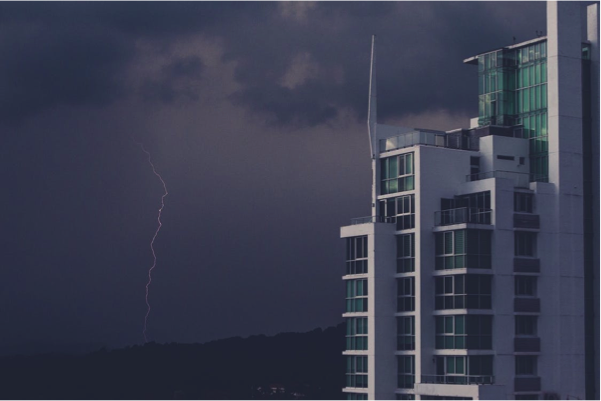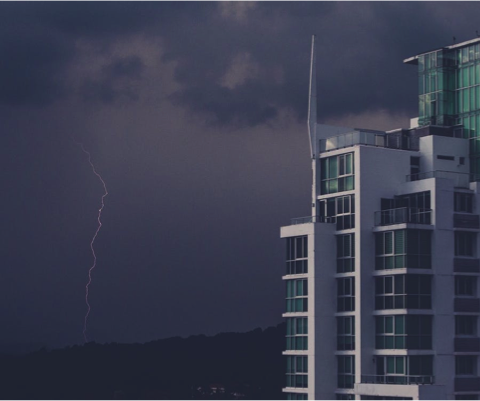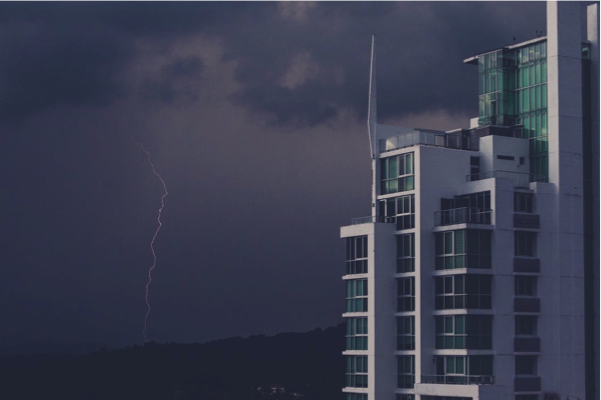 Around the world, there are approximately 100 lightning strikes each second. Exactly where each will strike is indeterminable, and their occurrence is unpreventable.
Around the world, there are approximately 100 lightning strikes each second. Exactly where each will strike is indeterminable, and their occurrence is unpreventable.
What is in our control, however, is the implementation of lightning protection systems where necessary. Effective systems capture lightning strikes and provide a dependable path for the energy to earth, dissipating it to prevent harm to structures or individuals.
Assess the known risks of lightning in your situation to help you recognize what level of lightning protection is needed to plan for an unexpected strike.
Although no strict rules can be given, it is possible to use broad guidelines to arrive at the degree of protection required. Below are 10 fundamental questions to help you assess your need for lightning protection.
10 Critical Factors to Consider
Do you need a lightning protection system? Start with these 10 critical questions to help you consider the level of lightning protection required for your needs.
1. What is the risk to personnel?
The odds of being struck by lightning in the U.S. this year are 1 in 700,000.
Make the safety of workers and other individuals the number one concern when considering lightning protection. Examples of locations where personnel risk should be assessed include factories, schools, farms, churches, sporting facilities, and hospitals.
2. What is the risk of equipment or structural damage?
Lightning can cause direct damage from the strike or indirect electrical-related damage. Direct strikes damage roofing materials, heating and air conditioning units, and other exterior parts of a structure. Indirect damage can result from the lightning current traveling by electric grids or through utility lines.
3. What are the consequential problems of such failure?
Consider the level of damage caused through direct or indirect strikes and the potential related costs incurred. For a business, will costly repairs need to be completed? Will your level of customer service be compromised? What is the opportunity cost of production downtime? Consider all qualitative and quantitative side effects of a failure caused by lightning.
4. Is the equipment associated with an essential or public service?
Think about the necessity level of the structure or area: will the public or customers be directly affected by downtime? Railroads, hospitals, airports and public utilities, for example, must look beyond their own initiatives to consider the public that would be affected by interruptions.
5. Is there likely to be substantial revenue loss in the time required to restore services?
From a business point of view, will the corresponding downtime caused from lightning damage hurt the bottom line? Downtime is often an unavoidable aspect of business, but lightning protection systems may be beneficial in preventing detrimental, avoidable downtime and costly repairs due to equipment damage.
6. Is the structure of historical importance?
This question is a judgment call on the significance of the structure. Whether a historic church, government property, or park, deliberate the intangible historical value of the structure.
7. What are the legal implications of providing inadequate protection?
In your industry or geographic location, are you legally required to provide a certain level of lightning protection? For instance, aviation facilities have strict lightning protection guidelines detailed in the Code of Federal Regulations, while the U.S. Nuclear Regulatory Commission provides specifications for nuclear facilities. Check with industry and geographic regulations about potential lightning protection requirements.
8. Can the passage of a discharge in the structure or building give rise to side flashing or simple sparks in an explosive or flammable environment?
Is this a situation where the extraction and storage of gas or oil takes place, explosives are stored or manufactured, or something else critical presents an issue? Side flashing, for example, can injure individuals or damage structures located near taller objects. The lightning strikes the taller surface and a portion of the current jumps to a vulnerable structure or person.
9. Can side flashing between metallic structures cause damage to essential electronics?
Electronics are inherently susceptible to lightning strikes in the form of indirect damage. Be aware of electronics that are important and/or vulnerable to damage. A data center, for example, is a focal point of most business’ everyday operations. When the data center is debilitated from a lightning strike, the operations of an entire company may go down. See Google’s lightning incident in Belgium, for instance.
10. Will the discharge give rise to corona phenomena causing disastrous surges on the phase wires of electric lines or a breakdown in transformer stations?
Corona can create an audible noise that violates noise standards. These events can also interfere with communications and cause damage to conductors, transformers and other electronics.
Judging the Risks of Lightning-Associated Damage
Determining the level of lightning protection appropriate for each situation is not always simple. Consider the safety issues, costs and potential damage associated with lightning if you do not have a proper protection system. These ten questions should help you get started evaluating your potential need for lightning protection.
Subscribe to our blog to help your facility get prepared.
Image credit: Pexels


